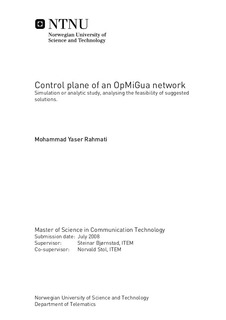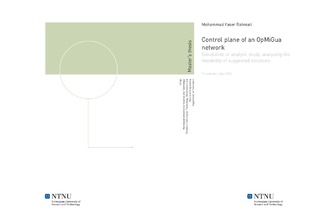| dc.contributor.advisor | Bjørnstad, Steinar | nb_NO |
| dc.contributor.advisor | Stol, Norvald | nb_NO |
| dc.contributor.author | Rahmati, Mohammad Yaser | nb_NO |
| dc.date.accessioned | 2014-12-19T14:12:23Z | |
| dc.date.available | 2014-12-19T14:12:23Z | |
| dc.date.created | 2010-09-03 | nb_NO |
| dc.date.issued | 2008 | nb_NO |
| dc.identifier | 347717 | nb_NO |
| dc.identifier | ntnudaim:4183 | nb_NO |
| dc.identifier.uri | http://hdl.handle.net/11250/261766 | |
| dc.description.abstract | This report contains the introduction and result of the master s thesis studied in the last semester of my study in the NTNU in 2008. The thesis was about studying a control plan for OpMiGua by using the existing technologies and solutions. For this propose a solution was suggested and a simulation is developed to test this solution. The report starts with an introduction of different networking techniques and the motivation for the OpMiGua. The report contains mainly three parts. The first part is the theoretical and technical background, where the Optical network and different technologies around that is introduced, including OpMiGua network and Control plan techniques as MPLS and GMPLS. The first part is from chapter 1 to 4. Second part is about the use of GMPLS in the OpMiGua and the way of use it with respect to the classification of traffic. It is introduced in the chapter 5. Introducing continues with the solutions as GST_LSP, a path for the GST packets and how it can be established and how the packets can be labeled. It also introduces the SM_LSP, a path for SM packets and its properties and differences in compare to GST_LSPs. The last part begin from chapter 6 through 9 where an analyses of the GST_LSP establishment is performed, a simulation structure is explained and the result of the simulation is discussed with respect to updating rate of the Gasco (Gaps statistic container ) which is a database in the suggested solution. The simulation is developed in view of the establishment process of GST-LSPs and the kind of information about each GST_LPSs which is aimed to update the Gasco with. The simulation also extended to study the SM-LPS switching request (or request for establishment) by using the data in the Gasco, and see what is the degree of successfulness of the SM_LSPs requests. The simulation of GST_LSP is about how this kind of path routes and establishes by using of GMPLS properties. This include finding shortest path in the studied network1, establishing the path by using wavelength labeling introduced in the GMPLS and when a path is established , traffics generates and sends through the path. The second process in the simulation is about what and how properties of the data which are flowing in the GSL path is going to be recorded and sends to the Gasco. The main property which is suggested to be importance in this study is peak delay or in another word, the longest burst duration in a path in different periods. This peak delay registers in the Gasco and is used to find the proper path for SM-LSP with respect to longest time a SM packet should with before it sends through the SM- path. Chapter 9 which contain a conclusion and a further work ends the report. | nb_NO |
| dc.language | eng | nb_NO |
| dc.publisher | Institutt for telematikk | nb_NO |
| dc.subject | ntnudaim | no_NO |
| dc.subject | SIE7 kommunikasjonsteknologi | no_NO |
| dc.subject | Telematikk | no_NO |
| dc.title | Control plane of an OpMiGua network: Simulation or analytic study, analysing the feasibility of suggested solutions. | nb_NO |
| dc.type | Master thesis | nb_NO |
| dc.source.pagenumber | 70 | nb_NO |
| dc.contributor.department | Norges teknisk-naturvitenskapelige universitet, Fakultet for informasjonsteknologi, matematikk og elektroteknikk, Institutt for telematikk | nb_NO |

